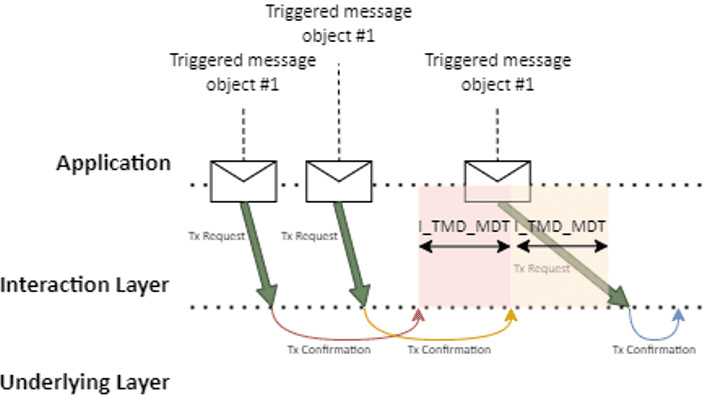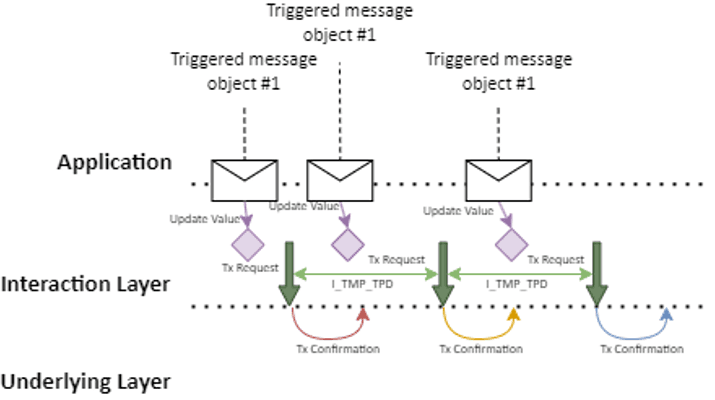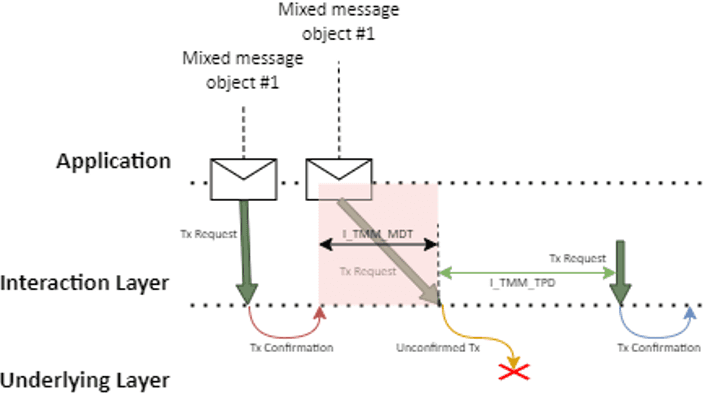COM - Demystifying I-PDU Transmission Modes
Understanding the transmission modes of I-PDUs at the Autosar COM is crucial for understanding how communication unfolds within an Autosar environment. There are three transmission modes: direct, periodic, mixed and none, each with its unique characteristics.
Direct Transmission Mode
In the direct transmission mode, the transmission process kicks off when a message object (I-SIGNAL) with the triggered transfer property is sent. The COM (which is part of the Interaction Layer, IL for short) promptly forwards the request to the underlying layers. A Minimum Delay Time (I_TMD_MDT) can be configured to enforce a delay between transmissions. Notably, the delay only comes into play once the first transmission is confirmed. If the initial transmission isn't confirmed (due to deadline monitoring, for example), the second I-PDU transmission won't face any delay. This mechanism can be observed in the figure below:

COM Minimum Delay Time and Direct Transmission Mode Explained
Periodic Transmission Mode
Contrasting with direct mode, the periodic transmission mode involves scheduling the I-PDU to be sent repeatedly with a predefined period (I_TMP_TPD). Although each API call updates the I-PDU, it doesn't initiate a transmission request, even if the triggered transfer property is set for the I-SIGNALS participating in the I-PDU. The periodic transmission mode is described in the picture below:

COM Periodic Transmission Mode Explained
Mixed Transmission Mode
The mixed transmission mode combines elements of both direct and periodic modes. Here, the transmission can commence by triggering underlying services, similar to the direct mode. Additionally, a base cycle (I_TMM_TPD) is defined for periodic transmission. Triggered transmissions don't affect this value. A minimum delay (I_TMM_MDT) is also specified, restoring the periodic transmission request (PTR) countdown to the base cycle value. If no confirmation is received before reaching I_TMM_TPD or deadline monitoring indicates faulty communication, the transmission can start immediately. This process is illustrated in the picture below:

COM Mixed Transmission Mode Explained
Transmission Behavior
The combination of message / I-SIGNAL transfer properties and I-PDU transmission modes results in distinct transmission behaviors. The table below outlines these combinations:
| Message Transfer Property | I-PDU Transmission Mode | Transmission Behaviour |
|---|---|---|
| Pending | Direct | Not possible, never transmitted |
| Pending | Periodic | Periodic |
| Pending | Mixed | Periodic |
| Triggered | Direct | As soon as triggered, if possible |
| Triggered | Periodic | Periodic |
| Triggered | Mixed | As soon as triggered, if possible, or periodic if not triggered |
Lastly, if the transmission mode is set to none, the affected I-PDU will never be transmitted.
Author: Micael Coutinho (opens in a new tab)
References:
© AutosarToday —@LinkedIn